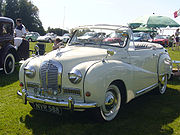
Austin A40 Somerset
Encyclopedia
- See Austin A40Austin A40A number of different automobiles were marketed under the Austin A40 name by the Austin Motor Company between 1947 and 1967.Austin's naming scheme at that time derived from the approximate engine output, in horsepower...
for other A40 models.
The A40 Somerset is an automobile
Automobile
An automobile, autocar, motor car or car is a wheeled motor vehicle used for transporting passengers, which also carries its own engine or motor...
sold by the Austin Motor Company
Austin Motor Company
The Austin Motor Company was a British manufacturer of automobiles. The company was founded in 1905 and merged in 1952 into the British Motor Corporation Ltd. The marque Austin was used until 1987...
from 1952 until 1954. It replaced the A40 Devon
Austin A40 Devon
The A40 Devon were automobiles marketed by the Austin Motor Company from 1947 to 1952 – the first post-war saloons to be produced by Austin – featuring a mix of old and new technologies...
and was quite similar to that body-on-frame
Body-on-frame
Body-on-frame is an automobile construction method. Mounting a separate body to a rigid frame that supports the drivetrain was the original method of building automobiles, and its use continues to this day. The original frames were made of wood , but steel ladder frames became common in the 1930s...
car, including using the same 1.2 L straight-4
Straight-4
The inline-four engine or straight-four engine is an internal combustion engine with all four cylinders mounted in a straight line, or plane along the crankcase. The single bank of cylinders may be oriented in either a vertical or an inclined plane with all the pistons driving a common crankshaft....
pushrod engine. The engine was updated to produce 42 hp (31 kW), however giving the car a top speed of 69 mi/h.
The Somerset featured an updated "Transatlantic" body style designed for export and resembled the larger A70 Hereford. It had a bench front seat and column mounted gear change. The Somerset was initially only a 4-door saloon, though a 3-passenger 2-door convertible
Convertible
A convertible is a type of automobile in which the roof can retract and fold away having windows which wind-down inside the doors, converting it from an enclosed to an open-air vehicle...
model made by Carbodies
Carbodies
Carbodies LImited is a British company based at Holyhead Road, Coventry. It started business as a coachbuilder, and now, as The London Taxi Company is best known for its production of London taxicabs.-History:...
of Coventry was also sold later. The 2-door and convertible differed from the 4-door cars in having separate front seats that folded forwards to give access to the rear.
The Austin Motor Company in 1953 made a "special" version of around 500 Somerset saloons with a more powerful engine, different interior appointments and two tone paintwork. The Austin Somerset special had a top speed of 74 mi/h while the normal saloon could reach up to 70 mi/h.
Over 173,000 were sold before the Somerset was replaced by the A40 Cambridge
Austin Cambridge
The Austin Cambridge is a motor car range sold by the Austin Motor Company in several generations from September 1954 through to 1969 as cars and 1971 as light commercials. It replaced the A40 Somerset but was entirely new with modern unibody construction...
in 1954. 7243 of them were convertibles

Performance
A convertible version tested by The MotorThe Motor (magazine)
The Motor was a British weekly car magazine founded on 28 January 1903....
magazine in 1953 had a top speed of 74 mph (119.1 km/h) and could accelerate from 0-60 mph (96.6 km/h) in 28.6 seconds. A fuel consumption of 30.1 mpgimp was recorded. The test car cost £705 including taxes. These figures were all obtained on the contemporary low octane fuel.
The Austin A40 Somerset has a reputation for being somewhat slow and lumbering to drive, and not wholly deserved.
The first A40 Somerset had to endure Pool quality petrol supplies (1952) and in consequence had retarded ignition settings to tolerate the low octane rating of this poor fuel grade to avoid the 'pinking' condition that was well known in those times.
In fact BMC later produced a kit to improve the performance and fuel consumption of these cars once premium fuel supplies resumed under the popular petrol brands. This kit comprised a replacement distributor and an optional head gasket for the cylinder head that was thinner and therefore raised the compression slightly from the standard 7.2:1.
The Autocar Road Test published 18 April 1952 achieved a maximum of 66 mph (106.2 km/h) (mean) and 71 mph (114.3 km/h) (best), and a 0-60 mph acceleration of 36.6 seconds whereas the example registered new in February 1954 and given a Used Car Test published in the Autocar series dated 8 April 1960 returned a 0-60 mph time of just 27.9 seconds. The standing quarter mile was down from 24.4 secs to 23.2 secs a marked improvement on the former result taken in 1952 and directly comparable with the Mini 850 launched in 1959, that was considered to be fairly brisk then.

